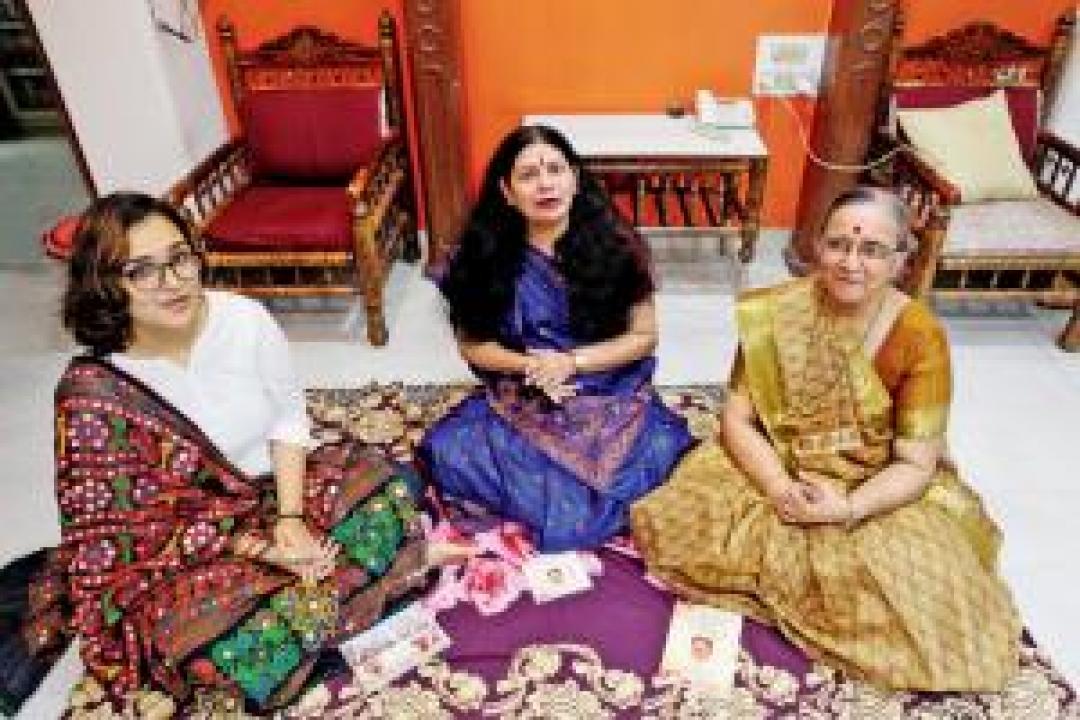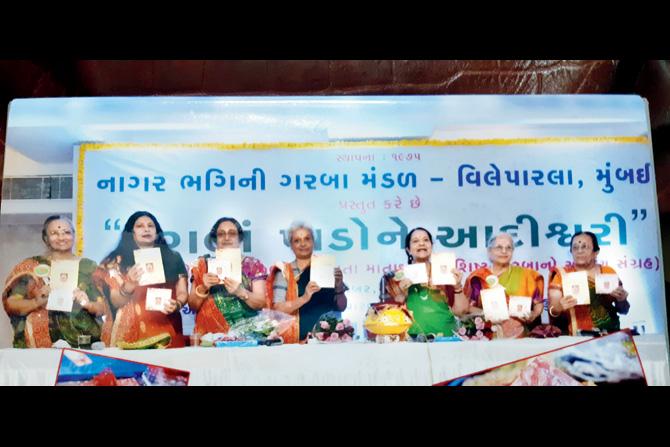A few homes of Hatkesh Society in Juhu celebrate Navratri with the unique 'sitting garba' which is sung, not danced, by women of the Nagar community citywide

Sulekha Baxi (extreme right) sings a betha garba sitting with her granddaughter Anjali and Dr Rajshree Trivedi (centre). Pic/ Ashish Raje
 Our hashtag is Jai Hatkesh!" says 85-year-old Dr Datta Rana spiritedly, handing me a glass of chilled khus doodh. We are soon joined by Naliniben Pandya, her neighbour in Juhu's Hatkesh Society. They are Nagar (pronounced Naagar) Gujaratis.
Our hashtag is Jai Hatkesh!" says 85-year-old Dr Datta Rana spiritedly, handing me a glass of chilled khus doodh. We are soon joined by Naliniben Pandya, her neighbour in Juhu's Hatkesh Society. They are Nagar (pronounced Naagar) Gujaratis.
Amid all the colour and chaos, the din of dandiya and dhol of Navratri, these women will thrill to an unusual beat. The vocal strains of the semi-classical "sitting garba" unique to the Nagar community.
Rather than swirl dance the "farta (whirling) garba", Nagar singers who practise "betha (sitting) garba" gather in a different home daily between 3 pm and 5 pm through Navratri. Their songs invite Mataji, the mother goddess descending from heaven to bless her earthly devotees. These lyrics flow in a smooth relay of unimaginable grace. The instant one woman nears a closing antaro (stanza) of a garba, the next picks up with opening notes of hers.
While this cadenced singsong echoes in Nagar pockets across town, it is the ladies of Hatkesh Society—Hatkesh is a name hailing Lord Shiva—that I'm privileged to hear. "Ameh vadhaareh Saraswati na pujari," declares Dr Rana. "We are more worshippers of Saraswati, goddess of learning. Be with her and Laxmi trails (with wealth). Each afternoon begins with a garba praising Mataji, performed by the lady of the house, followed by an aarti and simple prasad distributed like dry fruit or sharbat."
Demonstrating this distinct style, Dattaben breaks into the lilting: "Raksha karo, raksha karo Pavagadhwali/Meher karo Mahakali re—Protect us from evil, oh Devi/Bestow your divine grace." And Naliniben says, "Parla na garba sauthi saara. Ameh shu bhaav thi gaiye. Amaara lohi ma hoy. The garbas are best in Vile Parle. We sing with emotion. It's in our blood."

Mechanical engineer and IT consultant Nilesh Mankad with wife Trupti outside Parijat, built by their grandparents Hargauriben and Mukundrai Vatsaraj in 1958. Pic/ Ashish Raje
The ladies proceed to charmingly chorus a line from the lyric describing Shiva-Parvati's celestial chess game —"Saathe mali neh chaupat khele/Ishwar neh Sati Parvati"—composed by Ninu Majmudar, husband of thumri queen Kaumudi Munshi. Other renowned betha garba exponents include Veena Mehta and Paurvi Desai.
"I see these garbas as very important oral history, connecting generations of women," says Dr CS Lakshmi, founder-director of SPARROW (Sound and Picture Archives for Research on Women). Two years ago, she presided at a function organised by the Nagar Bhagini Garba Mandal of Vile Parle, releasing a book and audio CD of garbas. "There's such camaraderie and warmth while singing. When this genre originated, what other occasion did women have to come together? Being devotional doesn't imply it is not feminist. Feminism and faith can co-exist. Personally, I'm an atheist. But my mother did lovely pujas for which I enjoyed picking flowers. Tamil Bhakti poetry is so beautiful too. Why narrow experiences? Go with the power of whatever leaves you elated."
The first of their kind of institutionalised betha garbas were introduced in October 1955 by the Shree Vadnagara Nagar Mandal, a 111-year-old Nagar group. Dr Rajshree Trivedi, Principal of Maniben Nanavati Women's College, elaborates, "Betha garbas were sung at Nagar homes in Borivli, Kandivli, Malad, Ghatkopar, Goregaon, Santa Cruz, Charni Road and Grant Road, in the Ashvin month of Navratri. This now happens under the auspices of mandals."
 A view of Vatsalya, the Pandya family bungalow in Hatkesh Society, constructed in 1958
A view of Vatsalya, the Pandya family bungalow in Hatkesh Society, constructed in 1958
Vadnagar, near Ahmedabad, is the main Nagar settlement, along with Visnagar and Sathod. Dungarpar and Prashnipur, near Bhavnagar, are also the community's hubs. Between Ahmedabad and Patan, Vadnagar was a vital trading centre linked to Malwa, Saurashtra Rajputana and the Deccan.
Nagars identify with the poet Narsinh Mehta (1414-1481), revered in his native Junagadh and beyond. The Krishna devotee is hailed as Adi Kavi, first among bhakti poets. Four centuries later, his bhajan "Vaishnav jan toh", became one of Mahatma Gandhi's favourites. A gentle egalitarian soul, Narsinh was forced to face stern detractors. He was shunned by 15th-century Nagars for embracing the poor and "untouchables", though progressive Nagars today respect the example of inclusion he set.

A view of Vatsalya, the Pandya family bungalow in Hatkesh Society remodelled in 1981
In Pushpa Vatsalya, the apartment block replacing his family's Hatkesh Society bungalow, earlier called Vatsalya, Yashaswibhai Pandya tells me his grandfather taught Sanskrit to the royals of Jamnagar. The retired CA shares a photograph of his civil engineer father Kanchanlal C Pandya, who worked on constructing India's first atomic reactor and was personally introduced to Pandit Nehru and Dr Homi Bhabha. "Nagars were teachers, diwans and ministers in the kingdoms of Hindu and Muslim rulers," Yashaswibhai adds.
Eminent Nagar names bearing traces of Islamic interaction from medieval times include those of educationist Kallolini Hazrat and diplomat Chinmaya Gharekhan who represented India in Laos, Vietnam and Geneva, besides playing a pivotal role as UN-appointed special envoy in the Middle East peace process.
The Hindustani music world remains eternally enthralled by the tale of Tana and Riri. The mellifluous tones of these Nagar twins proved miraculous for Tansen. This gem among Emperor Akbar's eclectic Navratna once sang raga Deepak so fervidly, the darbar's unlit diyas came on. This was deliberately staged by jealous courtiers who realised the heat the virtuoso generated could blaze as much inward. Sure enough, Tansen broke into a relentless burning fever. Aware that his sole hope was a pure rendition of the monsoon raga Megh Malhar, he reached Vadnagar where Tana and Riri lived. Their soothing notes cooled his torment. An inspired Akbar summoned the girls to court. Dreading the wrath of conservative elders if they sang outside their village, the sisters committed suicide. An annual music festival takes place at their Vadnagar samadhi.
"Even initially home-tutored Nagar women grew up listening to legends such as Tana-Riri's," says Rajshree. "They have always been remarkably proficient in the arts. Sahitya and sangeet, literature and music, are prized. Earlier, they read religious texts, dharma granth. The first novel in 1865 by Bankim Chandra sharpened their curiosity for fiction."
Culturally inclined Nagars lay great value on education leading to life in the upper echelons of professions like medicine, engineering, law, chartered accountancy, IT, actuarial science and academics. This is true of Nagars globally, represented in healthy numbers in the diaspora. It is relatively rare to find Nagars pursue business dealings, given that Gujaratis generally show entrepreneurship. Nagars are said to be defined by five Ps: paan (betelnut), patiyu (swing), pujapo (puja paraphernalia), pitamber (silk dhoti) and panchat (gossip).
Rajshree's husband Parthiv, VP of Aquachem Enviro Engineers, mentions Nagar stalwarts who propelled freedom politics and uniting movements. Indulal Yagnik, helming the All India Kisan Sabha and Mahagujarat Andolan to demand separate statehood in August 1956, was known to have drawn heavier crowds to his meetings compared with Nehru's rallies, when both were held on the same day. Vaikunthlal Mehta pioneered the cooperative banking sector. He saw the influence of this effort spawn various offshoots, one being the Juhu-Vile Parle Development (JVPD) Scheme. Named after him, VM Road is forever packed with frenzied fans clicking selfies in front of the Bachchan bungalow Jalsa.
Hatkesh is one of 14 JVPD housing societies, conceived in the 1950s over 33 acres of swampy land leased for 999 years. Juhu island, once a sand bar rising above sea level by a metre or two, was called Juvem by the Portuguese. At its north point nestled Juhu village inhabited by Bhandaris (toddy tappers), Agris (salt traders) and Kulbis (cultivators).

CS Lakshmi (fourth from left), founder-director of the Sound and Picture Archives for Research on Women, at the release of a revival edition book and audio CD of "betha garbas" in Juhu during Navratri '17
Juhu's picnic spot rusticity as a weekend getaway for south-side citizens got an image change with some serious star swag. Arriving in the middle 1900s, Manoj Kumar, Dharmendra and Laxmikant-Pyarelal later greeted the Khans (the Juhu Khan brothers, Feroz, Sanjay and Akbar) and Bachchans here. Between them and the Azmis, Kabir and Protima Bedi, as well as newbies like Parveen Babi, Juhu's beach shack groove attracted what came to be called the Juhu Gang. The fastest
way I find the Trivedi home is by asking for directions to Hrithik Roshan's.
Slowly reclaiming what marsh tracts (Amboli Hill in Andheri was dug to fill this stretch) were affordable, Nagar families bought a majority of 80 Hatkesh Society plots, in and around the parallel 5th to 9th Roads. On achieving job stability and success, they built neat one-storey bungalows with open otlas. The first were Vatsalya, Karmayog, Parijat and Prerna, belonging respectively to the Pandyas, Mehtas, Mankads and Majumdars.
Naliniben Pandya says, "Mataji alone knows how long this lovely tradition will last. And Hatkesh homes may not be the bungalows our forefathers built. Still, sitting in these nice flats, we are grateful for the legacy and proud of the Nagars' contribution to society."
Author-publisher Meher Marfatia writes fortnightly on everything that makes her love Mumbai and adore Bombay. You can reach her at mehermarfatia@gmail.com / www.mehermarfatia.com
Catch up on all the latest Mumbai news, crime news, current affairs, and also a complete guide on Mumbai from food to things to do and events across the city here. Also download the new mid-day Android and iOS apps to get latest updates
 Subscribe today by clicking the link and stay updated with the latest news!" Click here!
Subscribe today by clicking the link and stay updated with the latest news!" Click here!










